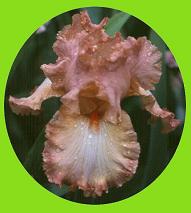
to the
Greater St. Louis Iris Society!
(Organized circa 1950)





Pests & Diseases
A friend of ours, John Weiler (iris hybridizer and long-time professor at Fresno State University in California) wrote in The World of Irises: "Irises are free of diseases and easy to grow!" "How many times [has] that statement been made by an enthusiastic writer in a magazine article, gardening book, or newspaper [?]. In recent years, though, as more gardeners have developed iris plantings and collections have expanded, the prevalence of several iris diseases has become more obvious."
Here in the Midwest not many diseases affect the iris but there are a few: bacterial leaf blight; fungal leaf spot; bacterial soft rot; and, fungal crown rot. Keeping your garden clean from debris goes a long way toward avoiding the conditions conducive to these diseases.
Bacterial leaf blight
The irises affected here are Bearded, Siberian, Japanese and the species I. tectorum. The pathogen is Xanthomonas tardicrescens. It shows up as very large irregular spotting near the margins of the upper leaf causing the leaf tips to turn brown. It is often confused with fungal leaf spot disease with its smaller spotting. There is no known cure for this blight but sanitary conditions are the best control. Keep dead leaves cleaned out of the garden and trim the affected plants. Be sure and disinfect your cutting tools after use so as not to spread the bacteria. This disease is extremely rare in the St. Louis area.
Fungal leaf spot
However, this fungal disease is pretty common in St. Louis. This presents as small circular to oval spots on the leaves, turning yellowish to brown and often developing a distinct red-brown border. The pathogen is Didymellina macrospora. It can affect all Bearded irises, Siberians, I. versicolor and the xiphiums, known as Dutch irises. The more rain we have the more prevalent it becomes. This is easy to control with the use of a fungicide and a sticker-spreader in your sprayer. Apply in the fall and early spring before infection. If infected, tip cut the affected leaves and apply again. Maneb and zineb have been proven effective.
Bacterial Soft Rot
In some years this can be a major problem that can almost wipe out a planting if allowed to spread without remedial action. The pathogen is Erwinia carotovora (yes, it affects carrots) and affects all the Bearded irises. It presents as a soft, foul-smelling rhizome rot followed by wilting and dying of the leaf fans. It is prevalent in wet springs with high temperatures. If you observe this and smell it, get busy cleaning it out! Use a spoon and scrape the infected tissue out. The rhizomes need to be exposed to the sun. We then douse the rhizomes in place with Dial antibacterial soap (with triclosan). We use this extensively at MOBOT with impressive results.
Fungal Crown Rot
This can affect Bearded irises, and rarely here Japanese, Siberian and Spuria irises. It presents as a gray or tan cottony mass over leaf bases and adjacent soil and rhizomes. The leaves turn yellow at the tip, rot at the base, and eventually fall over. Many times a secondary infection of bacterial soft rot will also occur. This fungus is most destructive during warm weather with moist soil. The pathogen is Sclerotium rolfsii, also know as mustard seed fungus, because it also presents as brown, spherical sclerotia, about the size and color of mustard seeds, when inactive. It is controlled by sanitary growing conditions, the cleaning out of infected tissue, exposure of the rhizomes to the sun, and at planting or transplanting time dipping the rhizomes in a fungicide or 10% Clorox solution.
When it comes to insect and animal Pests, there are many that can have minor to relatively major effect on the irises. Moles, voles, the recent appearance of armadillos from the south, aphids, crickets, verbena bud moth, cucumber beetles and Japanese beetles and the major problem here of the iris borer.
The Iris Borer
This critter is the scourge of the East and Midwest. Garden sanitation is most important to avoiding this borer. Study its life cycle: Macronoctua onusta is a caterpillar, the larvae of a medium-sized, nondescript noctural brownish moth. In autumn the moths lay their eggs on old iris leaves and other nearby debris. The eggs survive the winter and hatch out with warm weather in the spring. The tiny white caterpillars search out fresh iris leaves, which are usually less than a foot tall at this time. Early damage is hard to detect but as they grow they begin to attack the edges of the center foliage making notches and leaving slimy frass. If you catch them early you can crush them in the foliage with your fingers. Iris borers are proven cannibals with only one surviving by the time they are half-grown. But what damage that one can do as they proceed down the leaf sheaf or bloom stalk to the iris rhizome. The borer will hollow out the rhizome and sometimes migrate to an adjacent rhizome and do the same. They have to be dug out at this point and have grown to between one and two inches, are pinkish in appearance with dark brown heads. Ugly! In late summer they leave the rhizome entering the soil and becoming dark brown pupae. This dormant stage allows the caterpillar to transform into a moth which they do in autumn, when they emerge, mate and lay their eggs to start the process over.
Most pesticides are not effective against the iris borer. Garden sanitation and visual inspection of your plants is most important. Two systemic insecticides with reportedly good effect are Merit and Cygon 2E. Read the labels and apply sparingly with a spreader-sticker in early spring (when irises are about 4-6 inches tall) at least three times every 7-10 days. Eggs hatch at different times so you may get different batches dependent on the microclimate in your garden. Stay vigilant!
Aphids
These small green or gray insects are sapsuckers. They appear on the iris leaves in clusters and proceed to suck out leaf sap. They also can spread disease between plants. They are easily controlled by physical removal or crushing with your fingers. Lady bugs like them too. Spraying with an insecticidal soap or liquid dish detergent is effective.
Verbena Bud Moth
This critter appears to only be a problem for iris hybridizers who have seed pods developing from their iris crosses. The Endothenia hebesana, bud moth attacks the seed in the pods. It has the same life cycle as the iris borer. Sanitation and cleaning up seed stalks and capsules is the only known control.
Crickets
There are hundreds of species of crickets in the U. S. Crickets feed on just about everything. They will eat seeds, dead insects, leather, paper, old clothes (cotton, wool and silk), and plants. This includes the rhizome of the iris plant. They will eat holes in the rhizomes which can later be a home for pill bugs and result in soft rot from the rhizome's injury. Adult crickets spend their days in shallow burrows beneath stones, wood or plants. They are most active in late evening and the night when males begin their serenading to attract female mates. A cricket's life begins as one of about 300 eggs a female lays in the soil during late summer and fall. Some species overwinter as nymphs or adults, others as eggs which hatch in the spring. A year-old cricket is a rarity. Crickets can be controlled by a general purpose insecticide.
Pill Bugs or Roly-Polys
The common pill bug Armadillidum vulgare normally feeds on decaying vegetation but will burrow out holes begun by crickets in iris rhizomes. Called roly-polys in the St. Louis area, these little critters are found under stones, logs or any other space where moisture is found. When assuming a defensive posture, they curl up in a ball. They can be controlled by a general purpose insecticide.
Moles
This small brown burrowing mammal is in the Talpidae family. Its diet primarily consists of earthworms, grubs and other small invertebrates found in the soil. Their saliva contains a toxin that can paralyze earthworms. Because of this, moles are able to store their still living prey for later consumption. The problem they create for plants is the air space from their burrows causing plant stunting and non-bloom. Everyone has their own methods for trying to eliminate moles. The only sure way is to move to Ireland where they don't exist.
Voles
This small rodent is blackish brown to grayish brown, 5-8 inches long resembling a mouse but with a stouter body, a shorter hairy tail, a slightly rounder head with pointy nose, and smaller ears and eyes. They live underground in burrows (often using a mole's) but travel aboveground through runways they make by eating everything in their path, be it grass, herbaceous plants, bulbs, tubers and even tree roots or tree bark at the ground level. They can be controlled by toxic baits, such as the anticoagulants brodifacoum and bromadiolone, and by trapping. I use mouse traps with a piece of cheese placed right in their run. They seldom veer off these runs.
© 2011 - Greater St. Louis Iris Society

